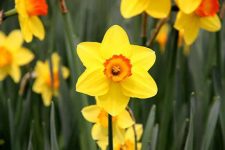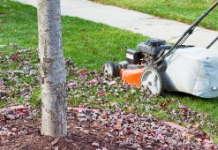Horticulture, health experts promote the ‘power of nature’
Nature is the daily pill we all need to live healthier lives, and Texas A&M University is laying the groundwork to lead the nation toward its healing powers.
The conversation about nature, green spaces, even houseplants’ abilities to wash away stress, anxiety and heal physical ailments has been gaining momentum for years, but Charlie Hall, Ph.D., professor and Ellison Chair in International Floriculture in the Texas A&M Department of Horticultural Sciences, is organizing to bring it to the forefront for a nation in crisis.
Mental and physical health in the U.S. is at crisis levels, he said. Hall and a growing number of scientists, health care professionals and green industry leaders hope to change individual behaviors and stakeholder attitudes related to nature and natural spaces.
Focus on growing human-nature disconnect
Jay Maddock, Ph.D., Regents professor in the Texas A&M School of Public Health and director of the Center for Health and Nature, presented at the 24th Ellison Distinguished Chair lecture and focused his talk on the impacts of a growing human-nature disconnect. Maddock, a psychologist, researches the social ecological ways to promote physical activity and engagement with nature.
Maddock’s presentation coincided with a brainstorming session among faculty from departments across Texas A&M University, professionals within the green industry, and public health officials and program specialists with the Texas A&M AgriLife Extension Service, including Texas Master Gardeners and early childhood development.
Attendees met to identify action items for these entities to use in promoting the concept and mobilizing activities around it.
“I’m encouraged by the range of fields that came together to discuss this topic because nature’s impact on our body and mind is a message we need to effectively deliver to policymakers and the public at large,” Hall said. “Implementing nature and plants into our daily lives may not sound like innovative thinking, but research has shown that it is an answer for a sustainable and healthy society, to address the economic impact of illnesses and to improve the overall quality of our lives.”
Connecting with nature improves health
During his presentation, Maddock cited “an incredible need for a better approach to mental and physical health in the U.S.” The high and rising rates of chronic diseases and diabetes, depression, substance abuse and deaths of despair, such as suicide or overdoses, are all related to our disconnect from nature.
“We cannot treat ourselves out of the mental health crisis,” he said. “And we can’t spend our way out of the health care crisis by pumping money into reactive medicine. We need to address the roots of these societal problems.
“Humans are innately connected to the natural world and when removed from nature, bad things happen.”
Eight out of 10 Americans feel stressed at least once every two weeks, and stress is a precursor to many of these problems, he said. Meanwhile, the money Americans spend on health as a share of the U.S. gross domestic product has quadrupled since 1960 from 5% to 20%, Maddock said.
This disconnect grew from the introduction of television, but the advent of hand-held minicomputers that hold our attention in a variety of ways throughout the day has deepened the human-nature divide, he said.
In 2012, American adults spent just over four hours a day consuming digital media, including television and desktop/laptop computers, according to a survey by eMarketer. Adults consumed six hours of digital media, across television, computers and mobile devices like smart phones by 2018, and that total exceeded eight hours by 2022.
Urbanization is also fueling the disconnect, he said. The percentage of Americans living in urban areas has steadily risen since the 1930s, and now more than 80% of residents live in cities instead of the countryside.
Maddock said stakeholders including civic leaders, industry and the public, need to understand how these rapid shifts in behavior affect wellness. Understanding the benefits of nature and natural features should inform short- and long-term changes that could radically change public health.
Daily exposure to nature provides a long list of benefits to human health. Stress reduction, better sleep, lower anxiety, greater happiness and life satisfaction, improved immune function, lower blood pressure, better birth outcomes and childhood development, reduced obesity and diabetes, improved eyesight and an overall longer life are all directly related to the frequency and scale at which a person engages with nature.
“I want to create a daily placebo pill and tell patients that this pill only works if you take a 30-minute walk in nature,” he said. “It would make a huge difference in all these health issues.”
A new approach to public health
The spectrum of nature contact can range from passive exposure such as potted plants in the home or office and windows with a view of the outdoors to interactive activities like hiking or gardening and wilderness adventures. Several days in remote natural areas provide a richer quantitative effect on a person’s health than potted plants or a room with a view, Maddock said.
For instance, one study showed that hospital patients with a view of a park from their hospital bed resulted in a speedier post-operation recovery time with less need for pain medication and fewer complications than patients without a view of nature.
Urban dwellers brought into a natural environment reported less mental fatigue, less irritability and saw their concentration and ability to problem solve increase.
Even virtual reality nature has been shown to provide a measurable positive impact to patients, he said.
Hall and Maddock hope policymakers and decision-makers recognize this opportunity and begin to rethink how green spaces, natural features and parks can be implemented in urban environments both indoors and outdoors.
Houston’s Bayou Greenway approach to a park system is the type of project they hope can be duplicated around the country on various scales. Bayou Greenway is a 3,000-acre, $220 million public-private partnership that provides 150 miles of trails in and around the city’s bayou system.
Maddock said access to trails and green spaces that promote activity in urban settings is important because a study from his research team showed that obesity-related hospital admissions dropped 93% in Houston zip codes within a 10-minute walk of the Bayou-Greenway trail system. Ischemic heart disease admissions dropped 77% and heart attack admissions dropped 71% in those same zip codes.
“Having trails near your home is connected to a reduction in hospitalizations,” he said. “That’s a huge effect, and of course we know it’s a correlational study, but from this large scale we are highly encouraged that it made a difference. That type of data is what has me geeked out about this effect of nature. It extends life, and you can’t have a better outcome than that.”
Hall and Maddock said they hope institutions like hospitals and universities will consider employing methods that provide access to or deliver nature to spaces like hospital rooms and classrooms in ways that enhance healing and learning, respectively.
Hall said the leadership team will follow through on recommendations and ideas developed by the initial “brainstorming group,” which plans to meet again next year. He and Maddock hope to see signs of momentum within the Department of Horticultural Sciences and among the various internal and external stakeholders by then.
“This is such an important message,” Hall said. “I think we can call it a mission now, and I believe Texas A&M is uniquely positioned to be a leader, a facilitator and partner within this movement to reconnect people with the healing power of nature and greenscapes.”




